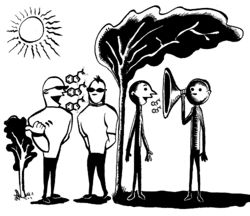Difference between revisions of "Regulatory network of the shade avoidance"
| Line 4: | Line 4: | ||
In a joint work with the lab of Christian Fankhauser at CIG, UNIL, we showed that plants adapt their hormonal signal to the availability of resources when avoiding shade. If resources are scarce, the signal is weaker but the sensitivity is enhanced but when the signal is abundant, a stronger and more robust signal is produced. Our study, which thus suggests that the plant optimizes a signal cost-to-robustness trade-off, has just been published in <a href="http://www.pnas.org/content/early/2014/04/11/1320355111.abstract" target="_blank">PNAS</a>. | In a joint work with the lab of Christian Fankhauser at CIG, UNIL, we showed that plants adapt their hormonal signal to the availability of resources when avoiding shade. If resources are scarce, the signal is weaker but the sensitivity is enhanced but when the signal is abundant, a stronger and more robust signal is produced. Our study, which thus suggests that the plant optimizes a signal cost-to-robustness trade-off, has just been published in <a href="http://www.pnas.org/content/early/2014/04/11/1320355111.abstract" target="_blank">PNAS</a>. | ||
</teaser> | </teaser> | ||
| − | [[Image: | + | [[Image:ShadeAvoidanceCartoon.jpg|Metaphorical illustration of the theory: Plants with direct access to sun light (left) have more energy and can send a stronger signal, whereas shaded plants (right) have less energy and thus send a weaker signal requiring increased sensitivity. Drawn by Miguel Giraldo. | thumb|250px]] |
When perceiving neighboring plants, Arabidopsis seedlings send an hormonal signal triggering stem elongation in order to secure access to unfiltered sunlight. This happens when they are already shaded by the neighboring plants but also before those neighbors are shading them. In those two cases, the plants send a growth hormone, auxin, from the leaves and to the stem, leading to its elongation. However the availability of resources is very different in both cases. When the plant is already shaded, its light resources are limited, which is not the case when the plant is in the sun. We thus compared auxin signalling in those two situations and found that in true shade a weaker signal is sent, but the sensitivity to auxin is enhanced. In contrast, when light is abundant, more auxin is produced, leading to a stronger signal and reduced sensitivity. As a result, the signal is indeed more robust when resources are abundant, hinting at a cost-to robustness trade-off, which lies at the heart of information theory. | When perceiving neighboring plants, Arabidopsis seedlings send an hormonal signal triggering stem elongation in order to secure access to unfiltered sunlight. This happens when they are already shaded by the neighboring plants but also before those neighbors are shading them. In those two cases, the plants send a growth hormone, auxin, from the leaves and to the stem, leading to its elongation. However the availability of resources is very different in both cases. When the plant is already shaded, its light resources are limited, which is not the case when the plant is in the sun. We thus compared auxin signalling in those two situations and found that in true shade a weaker signal is sent, but the sensitivity to auxin is enhanced. In contrast, when light is abundant, more auxin is produced, leading to a stronger signal and reduced sensitivity. As a result, the signal is indeed more robust when resources are abundant, hinting at a cost-to robustness trade-off, which lies at the heart of information theory. | ||
Latest revision as of 14:59, 15 February 2017
When perceiving neighboring plants, Arabidopsis seedlings send an hormonal signal triggering stem elongation in order to secure access to unfiltered sunlight. This happens when they are already shaded by the neighboring plants but also before those neighbors are shading them. In those two cases, the plants send a growth hormone, auxin, from the leaves and to the stem, leading to its elongation. However the availability of resources is very different in both cases. When the plant is already shaded, its light resources are limited, which is not the case when the plant is in the sun. We thus compared auxin signalling in those two situations and found that in true shade a weaker signal is sent, but the sensitivity to auxin is enhanced. In contrast, when light is abundant, more auxin is produced, leading to a stronger signal and reduced sensitivity. As a result, the signal is indeed more robust when resources are abundant, hinting at a cost-to robustness trade-off, which lies at the heart of information theory.
This work is a result of a collaboration with the lab of Christian Fankhauser and CIG, UNIL within the framework of the SystemsX.ch project "Plant Growth in Changing Environment".
The source code used for this research is available under GPL. You can also listen to a short interview (in french) about this work on the Swiss Radio.
Hersch M, Lorrain S, de Wit M, Trevisan M, Ljung K, Bergmann S, Fankhauser C
Light intensity modulates the regulatory network of the shade avoidance response in Arabidopsis.
Proc Natl Acad Sci U S A: 2014 Apr 29, 111(17);6515-20
[PubMed:24733935]
[WorldCat.org:
ISSN
ESSN
]
[DOI]
( o)
